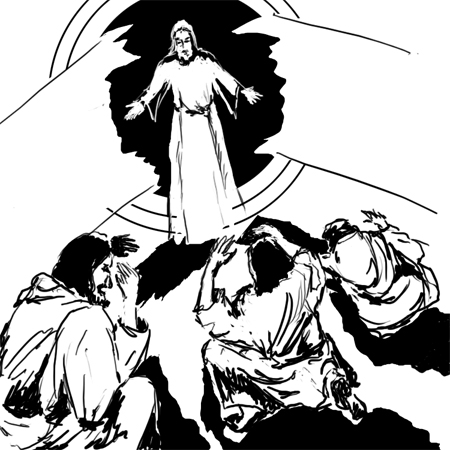 Transfiguration of the Lord, Year A, B, C
Transfiguration of the Lord, Year A, B, C
Dn 7:9-10, 13-14; 2Pt 1:16-19; A = Mt 17:1-9 (B = Mk 9:2-10; C = Lk 9: 28b-36)
Introduction: This is a homily/Scripture reflection in a book, titled: ‘Every Week God Speaks We Respond’, Cycle A, intended to be published in the future by Reverend John Tran Binh Trong.
It was published in Vietnamese in the US 2007 and republished in Viet Nam 2010. To keep the author’s writing style, this homily has not been edited and may not be by a hired hand. However, if readers would like to point out mistake(s) in spelling and grammar and/or to suggest English phrases and expressions, it would be greatly appreciated by the author, whose English is not his mother tongue and who did not live in the US until his adulthood. Passive sentences are used intentionally in this context as to avoid using the first personal pronoun ‘I’ when applicable. That might be associated with any idea of egotism, in accord with the French saying, known as: ‘Le moi est haissable’ (The ego is detestable).
In the Old Testament, God appeared to his people in a cloud, in a bush and in the desert. As God appeared to Moses and Elijah in a cloud, Jesus was transfigured in a cloud before the apostles on a mountain (Mt 17:1-2; Mk 9:2; Lk (:28-29). Therefore, the cloud was considered the symbol of God’s appearance in the Old Testament time. Jesus realized his passion and death would leave a painful experience for Peter, James and John who would witness his Gethsemane agony.
Therefore, he took the apostles to the top of the mountain and transfigured himself before their eyes to show them the glory of his kingdom and to bolster their faith in the prospect of his suffering and cross. The mountain suggested in tradition for the Transfiguration is Mount Tabor, in southern Galilee, only 1850 feet high, but it looks steep when looking up from the bottom.
A spiral road has been built for taxi drivers to take pilgrims to the top of the mountain. At that time, Jesus must have used his spiritual power to lift himself and the apostles up. Why was there presence of Moses and Elijah in the transfiguration (Mt 17:3; Mk 9:4; Lk 9:30)? According to the Jewish tradition, Moses was considered as the gathering and unifying author of the Pentateuch, representing the Law; and Elijah was considered the greatest prophet in the Old Testament, representing the prophets. Also according to the Jewish tradition, Moses and Elijah would return at the end of time. Thus, the presence of Moses and Elijah was intended to help the apostles realize Christianity to be founded by their Master would not be separated from what was written in the Old Testament and thus to help them to be assured to follow their master without being in a quandary.
Similar to the transfiguration, the prophet Daniel in a vision saw a similar scene, also using the word Son of man (Dn 7:13) like Jesus used in the Transfiguration. However, the word Son of man, which Daniel used, meant a certain super individual. In the gospel, Jesus reserved to himself the title Son of Man, implying his divinity and his human nature. As for the Ancient One whom Daniel referred to (Dn 7:9, 14) implied the one who uttered a voice: This is my beloved Son (Mt 17:5; Mk 9:7; Lk 9:35), meaning God the Father in the transfiguration scene. Jesus showed the three key apostles Peter, James and John the glory of his kingdom so that they might be steadfast in their faith on Good Friday and helped keep the faith of their fellow apostles. Yet in the courtyard of the high priest, out of fear, Peter denied his Master three times.
Blessed is Peter, when he heard a cockcrow, recalling Jesus’ prediction, he broke down and began to weep (Mk 14:72). His tears flowed out as if he repented, saying to his Master: How could I deny you when I had asked your permission to stay on the mountain to behold the glory of your kingdom? Besides, a moment before, I just drew my sword and cut off the ear of the high priest’s slave, and yet how could I be so cowardly? Thus, the realities of the Transfiguration: the cloud, Jesus’ clothes becoming dazzling white, the presence of Moses and Elijah, the voice spoken from the cloud are aimed to help the apostles realize the agony and cross of their Master would not be a failure, but a transformation: from the cross to the resurrection. After the Transfiguration, Jesus told the apostles not to tell anyone about it until the Son of man had risen from the dead. According to the gospel, the apostles kept his words but still wondered what rising from the dead meant?
After the resurrection, Peter related the Transfiguration to his faithful community and mentioned a voice from heaven: This is my Son, my beloved, with whom, I am well pleased (2Pet 1:17). That is the voice of the Father, which Saint Mark related in his gospel: This is my beloved Son. Listen to him (Mt 17:5; Mk 9:7; Lk 9:35). On this Transfiguration, the Church wants to teach us two truths. First, Jesus has two natures: divine and human nature.
Secondly, someday, we shall participate in the glory of God’s kingdom. How honored and comforted, when we, his disciples, carry within ourselves a body with sickness and sinfulness, disease and death, yet can share in the glory of his resurrection. Saint Peter, in his religious uplift, asked Jesus to stay on the mountain as to able to contemplate the glory of his kingdom and to be immerged in the heavenly scene.
He did not realize it was not time for him to stay up there yet. He had to go down the mountain again, to bear witness to the Lord, to suffer and die with him, before he could go up the mountain again. That is the way of Christianity: Through the cross to the resurrection. Being Jesus’ disciples, how can we go a different way?
Prayer asking to contemplate God’s glory:
Lord Jesus, as you transfigured yourself
to show the apostles the glory of your kingdom,
grant that I may feel your presence
in this life, so that I may rest assured to follow you
and that I may see your glory in the life to come.
Be my hope and my longing. Amen.
John Tran Binh Trong



 Every Week God Speaks – We Respond, Cycle A was published Online in the US. The introduction of the book is recorded at “Sách của Tác giả Chủ trương, Column 1.
Every Week God Speaks – We Respond, Cycle A was published Online in the US. The introduction of the book is recorded at “Sách của Tác giả Chủ trương, Column 1.

 Năm Mục Vụ Giới Trẻ 2021. HĐGM ấn định một chương trình Mục vụ Giới trẻ 3 năm với các chủ đề tương ứng: Năm 2020: Đồng hành với người trẻ hướng tới sự trưởng thành toàn diện.
Năm Mục Vụ Giới Trẻ 2021. HĐGM ấn định một chương trình Mục vụ Giới trẻ 3 năm với các chủ đề tương ứng: Năm 2020: Đồng hành với người trẻ hướng tới sự trưởng thành toàn diện. Năm Thánh Giu-se: Nhân kỷ niệm 150 năm Đức Giáo hoàng Pio IX chọn thánh Giuse làm Đấng Bảo Trợ Giáo Hội Công Giáo, Đức Phanxicô đã ban hành Tông thư “Patris corde” – Trái tim của người Cha – và công bố “Năm đặc biệt về thánh Giuse” từ
Năm Thánh Giu-se: Nhân kỷ niệm 150 năm Đức Giáo hoàng Pio IX chọn thánh Giuse làm Đấng Bảo Trợ Giáo Hội Công Giáo, Đức Phanxicô đã ban hành Tông thư “Patris corde” – Trái tim của người Cha – và công bố “Năm đặc biệt về thánh Giuse” từ  Năm “Gia đình Amoris Laetitia” 2021 về “Vẻ đẹp và niềm vui của tình yêu gia đình” do Bộ Giáo Dân, Gia Đình và Sự Sống tổ chức, được Đức Phanxicô khai mạc dịp Lễ Thánh Giuse
Năm “Gia đình Amoris Laetitia” 2021 về “Vẻ đẹp và niềm vui của tình yêu gia đình” do Bộ Giáo Dân, Gia Đình và Sự Sống tổ chức, được Đức Phanxicô khai mạc dịp Lễ Thánh Giuse 
